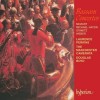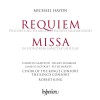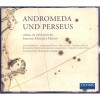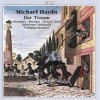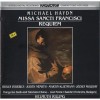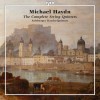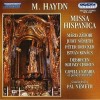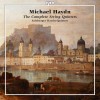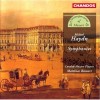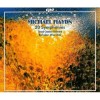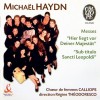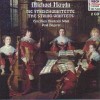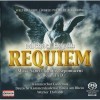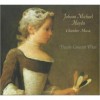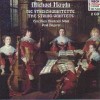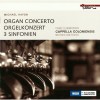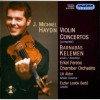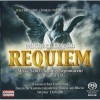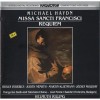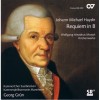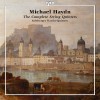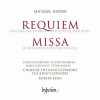传记
Johann Michael Haydn (14 September 1737 – 10 August 1806) was an Austrian composer of the Classical period, the younger brother of Joseph Haydn.
Michael Haydn was born in 1737 in the Austrian village of Rohrau, near the Hungarian border. His father was Mathias Haydn, a wheelwright who also served as "Marktrichter", an office akin to village mayor. Haydn's mother Maria, née Koller, had previously worked as a cook in the palace of Count Harrach, the presiding aristocrat of Rohrau. Mathias was an enthusiastic folk musician, who during the journeyman period of his career had taught himself to play the harp, and he also made sure that his children learned to sing; for details see Mathias Haydn.
Michael's early professional career path was paved by his older brother Joseph, whose skillful singing had landed him a position as a boy soprano in the St. Stephen's Cathedral, Vienna choir under the direction of Georg Reutter, as were Johann Georg Albrechtsberger and Franz Joseph Aumann,[1] both composers Haydn later traded manuscripts with. The early 19th-century author Albert Christoph Dies, based on Joseph's late-life reminiscences, wrote:[2]
"Reutter was so captivated by [Joseph]'s talents that he declared to his father that even if he had twelve sons he would take care of them all. The father saw himself freed of a great burden by this offer, consented to it, and some five years after dedicated Joseph's brothers Michael, and still later Johann to the musical muse. Both were taken on as choirboys, and, to Joseph's unending joy, both brothers were turned over to him to be trained."
The same source indicates that Michael was a brighter student than Joseph, and that (particularly when Joseph had grown enough to have trouble keeping his soprano voice) it was Michael's singing that was the more admired.
Shortly after he left the choir school, Michael was appointed Kapellmeister at Nagyvárad (Großwardein, Oradea) and later, in 1762, at Salzburg, where he remained for 43 years, during which he wrote over 360 compositions comprising both church and instrumental music.
On 17 August 1768 he married singer Maria Magdalena Lipp (1745–1827); their only child, a daughter (Aloisia Josepha, born 31 January 1770) died just short of her first birthday (on 27 January 1771). Although Lipp was disliked by the women in Mozart's family for some reason.,[3] she still created the role of Barmherzigkeit ([Divine] Mercy) in Mozart's first musical play, Die Schuldigkeit des ersten Gebots (The Guilt of the First Commandment, 1767), and later the role of Tamiri in his short pastoral opera Il re pastore (1775).
Leopold Mozart criticized Haydn's heavy drinking.[4]
Haydn was acquainted with Mozart, who held his work in high esteem, and taught young Carl Maria von Weber[5] and Anton Diabelli.
Michael remained close to Joseph all of his life. Joseph regarded his brother's music highly, to the point of feeling Michael's religious works were superior to his own (possibly for their devotional intimacy, as opposed to Joseph's monumental and majestic more secularized symphonic style).[6] In 1802, when Michael was "offered lucrative and honourable positions" by "both Esterházy and the Grand Duke of Tuscany," he wrote to Joseph in Vienna asking for advice on whether or not to accept any of them, but in the end chose to stay in Salzburg.[7] Michael and Maria Magdalena Haydn named their daughter Aloisia Josepha (who was always called Aloisia) not in honor of Michael's brother, but after Josepha Daubrawa von Daubrawaick, who substituted as godmother at the baptism for Countess de Firmian.
He died in Salzburg at the age of 68.
Michael never compiled a thematic catalog of his works, nor did he ever supervise the making of one. The earliest catalog was compiled in 1808 by Nikolaus Lang for his 'Biographische Skizze' (Biographical Sketch). In 1907 Lothar Perger compiled a catalogue of his orchestral works, the Perger-Verzeichnis, for Denkmäler der Tonkunst in Österreich, which is somewhat more reliable than Lang's catalog and attaches P. (for Perger) numbers to many of Haydn's instrumental works. And in 1915 Anton Maria Klafsky undertook a similar work regarding Michael's sacred vocal music. In 1982, Charles H. Sherman, who has edited scores of many of his symphonies for Doblinger, published a chronological catalog of them which some recording companies have adopted. Later, in 1991, Sherman joined forces with T. Donley Thomas to publish a chronological catalog of Michael's complete works using a single continuous range of numbers after Köchel's pioneering catalog of all of Mozart's works and Otto Erich Deutsch's similar comprehensive compendium for all of Schubert's works. Further important amendments to the Sherman/Thomas catalogue have been made by Dwight Blazin.[8]
The task of cataloging Michael's music is facilitated by the fact that he almost always entered the date of completion on his manuscripts.[9] Guesswork was necessary only for autograph manuscripts that did not survive.
Haydn's sacred choral works are generally regarded as his most important, including the Requiem pro defuncto Archiepiscopo Sigismundo (Requiem for the death of Archbishop Siegmund) in C minor, which greatly influenced the Requiem by Mozart, Missa Hispanica (which he exchanged for a diploma at Stockholm), his magnificent last St. Francis Mass in D minor, the motet Lauda Sion he wished to have sung at his funeral and a set of graduals, forty-two of which are reprinted in Anton Diabelli's Ecclesiasticon. He was also a prolific composer of secular music, including forty symphonies and wind partitas, and multiple concertos and chamber music including a string quintet in C major was once thought to have been by his brother Joseph.
There was another case of posthumous mistaken identity involving Michael Haydn: for many years, the sprightly G major symphony now known to be Michael Haydn's Symphony No. 25 was thought to be Mozart's Symphony No. 37 and assigned K. 444. The confusion arose because an autograph was discovered with the opening movement of the symphony in Mozart's hand and the rest in another's hand. It is now known that Mozart composed the slow introduction to the first movement but the rest of the work is by Michael. This delightful work, which had been quite widely performed as a Mozart symphony, has unfortunately been performed considerably less often since this discovery in 1907.
Indeed, several of Michael Haydn's works influenced Mozart. To give just three examples: the Te Deum "which Wolfgang was later to follow very closely in K. 141"[10] the finale of the Symphony No. 23 which influenced the finale of the G major Quartet, K. 387, and the (fugal) transition and (nonfugal) closing theme of the G major second subject expositions of the finales of both Michael's Symphony No. 29(1784) and Mozart's monumental last Symphony No. 41 ("Jupiter") (1788), both in C major.





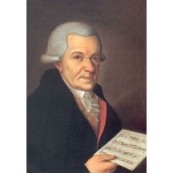

![Arthur Grumiaux - Philips Recordings 1955-1978 [CD 4 of 6]](http://static.classicalm.com/repository/disk-cover/small/3380-img1392035354606444.jpg)
![Mozart, Haydn M. - Duos for Violin & Viola - [CD1of2]](http://static.classicalm.com/repository/disk-cover/small/3135-img1382822402210636.jpg)
![Mozart, Haydn M. - Duos for Violin & Viola - [CD2of2]](http://static.classicalm.com/repository/disk-cover/small/3137-img1382822733104325.jpg)
